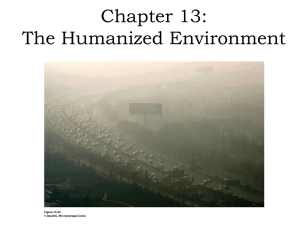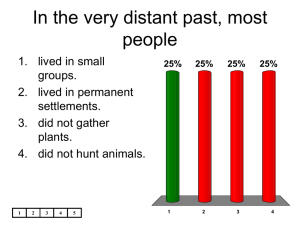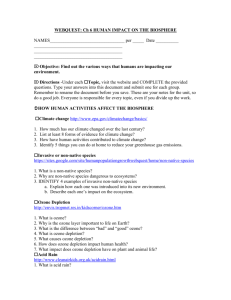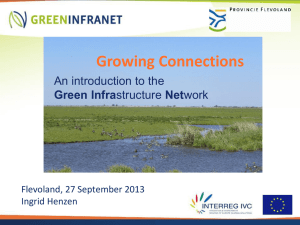Biology_Ch._6
advertisement
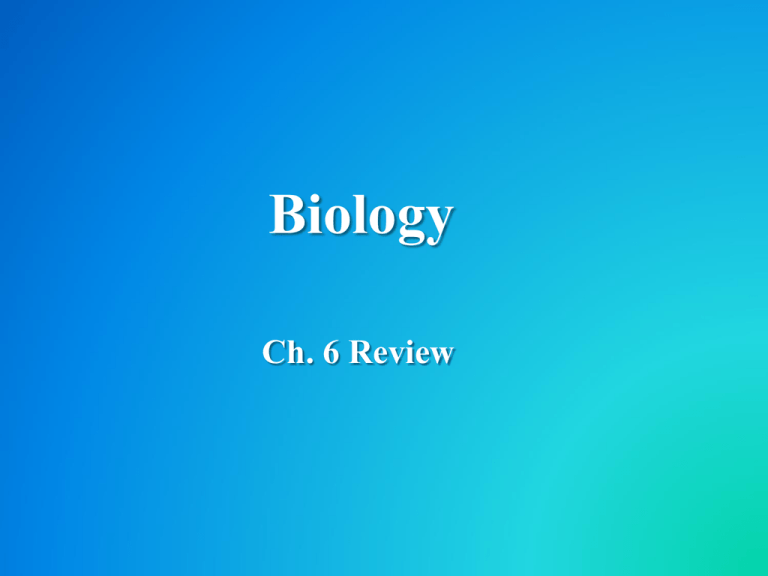
Biology Ch. 6 Review In the very distant past, most people A. lived in small groups. B. lived in permanent settlements. C. did not gather plants. D. did not hunt animals. 0% A. 0% B. 0% C. 0% D. Imported plants in Hawaii have A. crowded out many native species. B. reduced the native bird species. C. introduced diseases. D. depleted natural resources. 0% A. 0% B. 0% C. 0% D. The Americans, Europeans, and Asians who settled in the islands of Hawaii changed the islands by A. clearing vast areas for the growth of sugar cane. B. using large amounts of water. C. introducing nonnative crop plants. D. all of the above 0% A. 0% B. 0% C. 0% D. Early hunters and gatherers in North America may have been responsible for A. natural plant and animal populations. B. a major extinction event of large animals. C. producing new varieties of crops. D. inventing technology such as manufactured tools. 0% A. 0% B. 0% C. 0% D. Which has become the most important source of environmental change on Earth? A. B. C. D. climate energy human activity conservation biology 0% A. 0% B. 0% C. 0% D. An environmental problem that resulted from the green revolution was A. B. C. D. overpopulation. failed crops. starvation. depleted water supplies. 0% A. 0% B. 0% C. 0% D. Land is a resource that provides A. space for cities and suburbs. B. raw materials for industry. C. soil for growing crops. D. all of the above 0% A. 0% B. 0% C. 0% D. An old-growth forest is A. a renewable resource. B. a nonrenewable resource. C. a microclimate. D. poor in biodiversity. 0% A. 0% 0% B. C. 0% D. A resource, such as air or parts of the oceans, that is open to anyone is often preserved and protected by A. international organizations. B. everyone. C. the country in which it is located. D. no one. 0% A. 0% B. 0% C. 0% D. Why are fossil fuels nonrenewable? A. They require hundreds of millions of years to form. B. Their ecosystems change forever when they are burned. C. They are converted to carbon dioxide when they are burned. D. They exist in a very small supply. 0% A. 0% B. 0% C. 0% D. Using renewable resources while ensuring that they are not depleted is a practice called A. sustainable development. B. monoculture. C. biological magnification. D. subsistence hunting. 0% A. 0% B. 0% C. 0% D. An example of a sustainable-development practice is the use of beneficial insects like ladybugs to A. harm natural resources. B. pollinate plants. C. control unwanted pests. D. eat unwanted plants. 0% A. 0% B. 0% C. 0% D. Which is a way to limit deforestation? A. Use more wood products B. Plant and harvest trees on a tree farm C. Increase carbon dioxide levels D. Fertilize the soi; 0% A. 0% B. 0% C. 0% D. What concept should be practiced to live interdependently with nature’s systems? A. aquaculture B. recycling C. subsistence hunting D. sustainable development 0% A. 0% B. 0% C. 0% D. The sulfur and nitrogen compounds in smog combine with water to form A. B. C. D. ozone. ammonia. acid rain. CFC’s 0% A. 0% B. 0% C. 0% D. Of the following events, the last to occur when toxic chemicals are discarded into a stream is that the chemicals A. pose a threat to human health. B. enter the food chain. C. are carried into a lake. D. harm aquatic plants and animals. 0% A. 0% B. 0% C. 0% D. When erosion and other factors cause soil to lose its ability to hold water and other nutrients and to support plant life, it is called A. B. C. D. desertification. depletion. deforestation. monoculture. 0% A. 0% B. 0% C. 0% D. Which of the following is NOT considered a sustainable-development strategy for management of Earth’s resources? A. contour plowing B. desertification C. aquaculture D. drip irrigation 0% A. 0% B. 0% C. 0% D. The wearing away of surface soil by water and wind is known as A. B. C. D. deforestation. desertification. overgrazing. soil erosion. 0% A. 0% B. 0% C. 0% D. The number of different species in the biosphere is called A. biodiversity. B. ecosystem diversity. C. genetic diversity. D. species diversity. 0% A. 0% B. 0% C. 0% D. Biodiversity is important to human society because it A. is a natural resource. B. provides food and goods. C. provides medicines. 0% 0% 0% 0% D. all of the above A. B. C. D. The sum total of the genetically based variety of living organisms in the biosphere is called A. species diversity. B. sustainable development. C. biodiversity. D. conservation 0% 0% 0% 0% biology. A. B. C. D. Biodiversity is valuable in the biosphere because it A. gives us interesting things to look at. B. tells us about many other species. C. is the biological life-support system of our planet. D. provides humans with resistance to disease. 0% A. 0% B. 0% C. 0% D. What is meant by “a library of genetic information” in reference to biodiversity? A. The biodiversity of plants and animals is interesting to read about. B. All living organisms contain genetic information upon which humans can draw for future use. C. Species provide humans with many useful products to enhance our lives. D. We have much to admire in the many forms of life that surround us. 0% A. 0% 0% 0% B. C. D. Human well-being is tied to biodiversity because A. humans love to look at beautiful things. B. humans are part of the food webs and energy cycles that a great variety of organisms share. C. less biodiversity makes humans vulnerable to extinction. D. humans need a wide variety of animal species for hunting and wildlife products. 0% 0% 0% 0% A. B. C. D. An endangered species is A. a diseased animal. B. a dangerous predator. C. a group of organisms in danger of extinction. D. all organisms at the top of a food chain. 0% A. 0% B. 0% C. 0% D. DDT was used to A. B. C. D. fertilize soil. kill insects. form ozone. feed animals. 0% A. 0% B. 0% C. 0% D. One property that makes DDT hazardous over the long run is that DDT is A. B. C. D. an insecticide. a perfect pesticide. nonbiodegradable. deadly to herbivores. 0% A. 0% B. 0% C. 0% D. A. B. C. D. All of the following are threats to biodiversity EXCEPT biological magnification of toxic compounds. habitat fragmentation. invasive species. 0% 0% 0% species preservation. A. B. C. 0% D. One of the greatest threats today to biological diversity is A. old-growth forests. B. ozone depletion. C. habitat destruction. 0% 0% 0% 0% D. monoculture. A. B. C. D. As DDT moves up the trophic levels in food chains, or food webs, its concentration A. B. C. D. stays the same. increases. decreases. is eliminated. 0% A. 0% B. 0% C. 0% D. A major factor that negatively affects biodiversity is A. biological magnification. B. habitat fragmentation. C. the green revolution. D. nonrenewable energy. 0% A. 0% B. 0% C. 0% D. One of the goals of conservation biology is to A. enforce environmental laws. B. protect habitats. C. manage natural resources. D. all of the above 0% A. 0% B. 0% C. 0% D. An ecological “hot spot” is an area where A. habitats and species are healthy. B. hunting is encouraged. C. habitats and species are in the most danger of extinction. D. species diversity is too high. 0% A. 0% B. 0% C. 0% D. The goals of conservation biology include all of the following EXCEPT A. wise management of natural resources. B. introducing foreign species into new environments. C. preservation of habitats and wildlife. D. protection of biodiversity. 0% A. 0% B. 0% C. 0% D. Protecting ecosystem diversity is a goal of A. the green revolution. B. conservation biology. C. the captive breeding program. D. the United Nations. 0% A. 0% B. 0% C. 0% D. The “hot spot” strategy seeks to protect species in danger of extinction due to A. captive breeding programs. B. expanding national parks. C. human activity. D. all of the above 0% A. 0% B. 0% C. 0% D. Protecting an entire ecosystem will ensure that A. captive breeding programs will succeed. B. existing parks and reserves will expand. C. governments will set aside land. D. natural habitats and the interactions of many different species will be preserved. 0% A. 0% B. 0% C. 0% D. Overexposure to UV radiation can A. cause cancer. B. decrease organisms’ resistance to disease. C. damage eyes. D. all of the above 0% A. 0% B. 0% C. 0% D. An increase in Earth’s average temperature from the buildup of carbon dioxide and other gases in the atmosphere is called A. the greenhouse effect. B. ozone depletion. C. global warming. D. particulate dispersal. 0% A. 0% B. 0% C. 0% D. Some scientists think that global warming may be A. a natural variation in climate. B. a result of human activities. C. melting the polar ice caps. D. all of the above 0% A. 0% B. 0% C. 0% D. The major cause of ozone depletion is A. B. C. D. nitric acid. sulfuric acid. CFC’s ultraviolet light. 0% A. 0% B. 0% C. 0% D. What would be the most likely effect of an increase in the use of CFCs? A. The ozone layer would suddenly disappear. B. The ozone holes would get smaller. C. The ozone holes would get larger. D. There would be no effect on ozone in the atmosphere. 0% A. 0% B. 0% C. 0% D. Carbon dioxide is released into the atmosphere by all of the following EXCEPT the A. burning of fossil fuels. B. depletion of the ozone layer. C. burning of trees and forests. D. burning of gasoline 0% A. 0% B. 0% C. 0% D. The intensive farming practices of the green revolution led to the use of beneficial insecticides. A. True B. False 0% A. 0% B. By the end of the last ice age, humans began the practice of agriculture. A. True B. False 0% A. 0% B. Old-growth forests are a renewable resource. A. True B. False 0% A. 0% B. According to the principles of conservation biology, a sustainable system is efficient when it consumes as little energy and material as possible. A. True B. False 0% A. 0% B. Acidic gases are released into the air by combustion processes such as the burning of fossil fuels. A. True B. False 0% A. 0% B. Wetlands such as swamps can help purify water passing through them. A. True B. False 0% A. 0% B. A sustainable-development practice that can pollute water with fish wastes if not properly managed is catch limits. A. True B. False 0% A. 0% B. Most crop plants have wild relatives with useful traits such as resistance to disease. A. True B. False 0% A. 0% B. One of the values of biological magnification is its potential as a source for material that is beneficial to humankind. A. True B. False 0% A. 0% B. Biodiversity is important to humankind because we are part of it and dependent on it for our own survival. A. True B. False 0% A. 0% B. Substances that cannot be broken down into their elements by metabolic processes are biodegradable. A. True B. False 0% A. 0% B. An introduced species can drive an invasive species to extinction. A. True B. False 0% A. 0% B. Conservation goals must be weighed against economic costs. A. True B. False 0% A. 0% B. The main cause of the thinning of the ozone layer is global warming. A. True B. False 0% A. 0% B. A result of global warming might be a rise in sea level. A. True B. False 0% A. 0% B.
